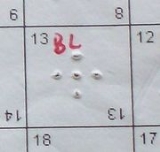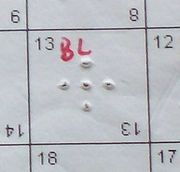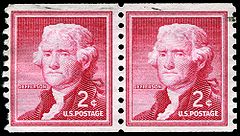
Perforation
Encyclopedia
A perforation is a small hole in a thin material or web. There is usually more than one perforation in an organized fashion, where all of the holes are called a perforation. The process of creating perforations is called perforating, which involves puncturing
the workpiece with a tool
.
Perforations are usually used to allow easy separation of two sections of the material, such as allowing paper
to be torn easily along the line. Packaging with perforations in paperboard
or plastic film is easy for consumers to open. Other purposes include filtrating fluids, sound deadening, allowing light or fluids to pass through, and to create an aesthetic design.
Various applications include packaging films
(to allow the contents to breathe), medical films, micro perforated plate
and sound
and vapor
barriers.

 Rotary pinned perforation rollers are precision tools that can be used to perforate a wide variety of materials. The pins or needles can be used cold or heated. Cold perforation tools include needle punches.
Rotary pinned perforation rollers are precision tools that can be used to perforate a wide variety of materials. The pins or needles can be used cold or heated. Cold perforation tools include needle punches.
There are a handful of manufacturers that specialize in hot and cold needle perforation tooling and equipment. In materials that have elasticity
this can result in a "volcano" hole that is preferred in many applications.
Pinned rollers can be made from a variety of materials, including plastic
, steel
, and aluminum.
In more brittle
films, cold perforation can cause slitting rather than creating a round hole, which can jeopardize the materials integrity under pressure. The solution to this is often heating the pin; i.e. hot pin perforation. Hot perforation melts a hole in the material, causing a reinforced ring around the hole. Hot needle perforation also assists when high density pin patterns are utilized, as the heat aids the perforation of the material.
. The workpiece is sheared by pressing (either by machine or hand tool) the punch
through the workpiece and into the die
. The middle section of the workpiece is scrap; commonly known as the chad
in paper and similar materials. The punch and die are shaped to produce the desired shaped hole. The clearance (the distance between the outside circumference of the punch and the inner circumference of the die) must be properly maintained to ensure a clean cut. Burrs are produced on the side of the workpiece that is against the die.
Common applications are fruit and vegetable bags, hole punch
ing and ticket punch
ing.
can place many precise holes in a web. Laser perforations look similar in many respects to hot needle perforations. However, laser systems are expensive. The big advantage of laser perforation is the consistency of the hole size, compared to mechanical perforation. This is very important in modified atmosphere packaging
for fresh produce.
 Perforation frequently refers to the practice of creating a long series of holes or slits so that paper
Perforation frequently refers to the practice of creating a long series of holes or slits so that paper
or plastic
s can be torn more easily along a given line: this is used in easy-open packaging. Since the creation of perforation devices in the 1840s and 1850s, it has seen use in several areas. Postage stamp
s are one common application of this, where small round holes are cut in lines to create individual pieces (see postage stamp separation
). Perforations on stamps are rather large, in the order of a millimeter, in comparison other perforated materials often have smaller holes. It is common for notebook
s and legal pads to have perforations making it easier to tear out individual pages. In today's cases, perforation is used in ways to separate loose leaf
(or even a form of graph paper from a ringed binder). A fine perforation next to the rings allows the page to be separated from the book with no confetti
. Screwcap
s on glass or plastic bottles are sealed with a ring at the bottom of the cap attached by perforation. Twisting the cap has the effect of rupturing the material between the perforations and indicating that the original seal has been broken.
 Film stock
Film stock
is perforated to allow it to be moved precise distances at a time continuously. Similarly, punched card
s for use in loom
s and later in computer
s input and output devices in some cases were perforated to ensure correct positioning of the card in the device, and to encode information.
Perforation of steel strips is used in the manufacture of some zesters and rasp
s.
Historically, perforation patterns other than linear were used to mark stamps (see Perfin
). Today, similarly elaborate perforation patterns continue to be used in orienteering
.
Puncturing
In coding theory, puncturing is the process of removing some of the parity bits after encoding with an error-correction code. This has the same effect as encoding with an error-correction code with a higher rate, or less redundancy...
the workpiece with a tool
Tool
A tool is a device that can be used to produce an item or achieve a task, but that is not consumed in the process. Informally the word is also used to describe a procedure or process with a specific purpose. Tools that are used in particular fields or activities may have different designations such...
.
Perforations are usually used to allow easy separation of two sections of the material, such as allowing paper
Paper
Paper is a thin material mainly used for writing upon, printing upon, drawing or for packaging. It is produced by pressing together moist fibers, typically cellulose pulp derived from wood, rags or grasses, and drying them into flexible sheets....
to be torn easily along the line. Packaging with perforations in paperboard
Paperboard
Paperboard is a thick paper based material. While there is no rigid differentiation between paper and paperboard, paperboard is generally thicker than paper. According to ISO standards, paperboard is a paper with a basis weight above 224 g/m2, but there are exceptions. Paperboard can be single...
or plastic film is easy for consumers to open. Other purposes include filtrating fluids, sound deadening, allowing light or fluids to pass through, and to create an aesthetic design.
Various applications include packaging films
Plastic wrap
Plastic wrap, cling film , cling wrap or food wrap, is a thin plastic film typically used for sealing food items in containers to keep them fresh over a longer period of time...
(to allow the contents to breathe), medical films, micro perforated plate
Micro perforated plate
A Micro Perforated Plate is a device used to absorb sound, reducing its intensity. It consists of a thin flat plate, made from one of several different materials, with small holes punched in it. An MPP offers an alternative to traditional sound absorbers made from porous materials.-Structure:An...
and sound
Sound
Sound is a mechanical wave that is an oscillation of pressure transmitted through a solid, liquid, or gas, composed of frequencies within the range of hearing and of a level sufficiently strong to be heard, or the sensation stimulated in organs of hearing by such vibrations.-Propagation of...
and vapor
Vapor
A vapor or vapour is a substance in the gas phase at a temperature lower than its critical point....
barriers.
Pins and needles


There are a handful of manufacturers that specialize in hot and cold needle perforation tooling and equipment. In materials that have elasticity
Elasticity (physics)
In physics, elasticity is the physical property of a material that returns to its original shape after the stress that made it deform or distort is removed. The relative amount of deformation is called the strain....
this can result in a "volcano" hole that is preferred in many applications.
Pinned rollers can be made from a variety of materials, including plastic
Plastic
A plastic material is any of a wide range of synthetic or semi-synthetic organic solids used in the manufacture of industrial products. Plastics are typically polymers of high molecular mass, and may contain other substances to improve performance and/or reduce production costs...
, steel
Steel
Steel is an alloy that consists mostly of iron and has a carbon content between 0.2% and 2.1% by weight, depending on the grade. Carbon is the most common alloying material for iron, but various other alloying elements are used, such as manganese, chromium, vanadium, and tungsten...
, and aluminum.
In more brittle
Brittle
A material is brittle if, when subjected to stress, it breaks without significant deformation . Brittle materials absorb relatively little energy prior to fracture, even those of high strength. Breaking is often accompanied by a snapping sound. Brittle materials include most ceramics and glasses ...
films, cold perforation can cause slitting rather than creating a round hole, which can jeopardize the materials integrity under pressure. The solution to this is often heating the pin; i.e. hot pin perforation. Hot perforation melts a hole in the material, causing a reinforced ring around the hole. Hot needle perforation also assists when high density pin patterns are utilized, as the heat aids the perforation of the material.
Die and punch
Die and punch sets can be used for thicker materials or materials that require large holes; this process is the most common for metalworkingMetalworking
Metalworking is the process of working with metals to create individual parts, assemblies, or large scale structures. The term covers a wide range of work from large ships and bridges to precise engine parts and delicate jewelry. It therefore includes a correspondingly wide range of skills,...
. The workpiece is sheared by pressing (either by machine or hand tool) the punch
Punch (tool)
A punch is a hard metal rod with a shaped tip at one end and a blunt butt end at the other, which is usually struck by a hammer. Punches are used to drive objects, such as nails, or to form an impression of the tip on a workpiece...
through the workpiece and into the die
Die (manufacturing)
A die is a specialized tool used in manufacturing industries to cut or shape material using a press. Like molds, dies are generally customized to the item they are used to create...
. The middle section of the workpiece is scrap; commonly known as the chad
Chad
Chad , officially known as the Republic of Chad, is a landlocked country in Central Africa. It is bordered by Libya to the north, Sudan to the east, the Central African Republic to the south, Cameroon and Nigeria to the southwest, and Niger to the west...
in paper and similar materials. The punch and die are shaped to produce the desired shaped hole. The clearance (the distance between the outside circumference of the punch and the inner circumference of the die) must be properly maintained to ensure a clean cut. Burrs are produced on the side of the workpiece that is against the die.
Common applications are fruit and vegetable bags, hole punch
Hole punch
A hole punch is a common office tool that is used to create holes in sheets of paper, often for the purpose of collecting the sheets in a binder or folder.The origins of the hole punch date back to Germany via Matthias Theel, where two early patents for a...
ing and ticket punch
Ticket punch
A ticket punch is a hand tool for permanently marking admission tickets and similar items of paper or card stock. It makes a perforation and a corresponding chad. A ticket punch resembles a hole punch, differing in that the ticket punch has a longer jaw and the option of having a distinctive...
ing.
Laser perforation
Laser cuttingLaser cutting
Laser cutting is a technology that uses a laser to cut materials, and is typically used for industrial manufacturing applications, but is also starting to be used by schools, small businesses and hobbyists. Laser cutting works by directing the output of a high-power laser, by computer, at the...
can place many precise holes in a web. Laser perforations look similar in many respects to hot needle perforations. However, laser systems are expensive. The big advantage of laser perforation is the consistency of the hole size, compared to mechanical perforation. This is very important in modified atmosphere packaging
Modified atmosphere
Modified atmosphere is the practice of modifying the composition of the internal atmosphere of a package in order to improve the shelf life....
for fresh produce.
Applications

Paper
Paper is a thin material mainly used for writing upon, printing upon, drawing or for packaging. It is produced by pressing together moist fibers, typically cellulose pulp derived from wood, rags or grasses, and drying them into flexible sheets....
or plastic
Plastic
A plastic material is any of a wide range of synthetic or semi-synthetic organic solids used in the manufacture of industrial products. Plastics are typically polymers of high molecular mass, and may contain other substances to improve performance and/or reduce production costs...
s can be torn more easily along a given line: this is used in easy-open packaging. Since the creation of perforation devices in the 1840s and 1850s, it has seen use in several areas. Postage stamp
Postage stamp
A postage stamp is a small piece of paper that is purchased and displayed on an item of mail as evidence of payment of postage. Typically, stamps are made from special paper, with a national designation and denomination on the face, and a gum adhesive on the reverse side...
s are one common application of this, where small round holes are cut in lines to create individual pieces (see postage stamp separation
Postage stamp separation
For postage stamps, separation is the means by which individual stamps are made easily detachable from each other.Methods of separation include:# perforation: cutting rows and columns of small holes...
). Perforations on stamps are rather large, in the order of a millimeter, in comparison other perforated materials often have smaller holes. It is common for notebook
Notebook
A notebook is a book or binder composed of pages of notes, often ruled, made out of paper, used for purposes including recording notes or memoranda, writing, drawing, and scrapbooking....
s and legal pads to have perforations making it easier to tear out individual pages. In today's cases, perforation is used in ways to separate loose leaf
Loose leaf
The term loose leaf is used in the United States, Canada, and some other countries to describe a piece of notebook paper which is not actually fixed in a spiral notebook...
(or even a form of graph paper from a ringed binder). A fine perforation next to the rings allows the page to be separated from the book with no confetti
Confetti
Confetti is a multitude of pieces of paper, mylar or metallic material which is usually thrown at parades and celebrations, especially weddings . Confetti is made in a variety of colors, and commercially available confetti is available in imaginative shapes...
. Screwcap
Screwcap
A screw cap or closure is a common type of closure for bottles, jars, and tubes.-Usage:A screw closure is a mechanical device which is screwed on and off of a "finish" on a container. Either continuous threads or lugs are used...
s on glass or plastic bottles are sealed with a ring at the bottom of the cap attached by perforation. Twisting the cap has the effect of rupturing the material between the perforations and indicating that the original seal has been broken.

Film stock
Film stock is photographic film on which filmmaking of motion pictures are shot and reproduced. The equivalent in television production is video tape.-1889–1899:...
is perforated to allow it to be moved precise distances at a time continuously. Similarly, punched card
Punched card
A punched card, punch card, IBM card, or Hollerith card is a piece of stiff paper that contains digital information represented by the presence or absence of holes in predefined positions...
s for use in loom
Loom
A loom is a device used to weave cloth. The basic purpose of any loom is to hold the warp threads under tension to facilitate the interweaving of the weft threads...
s and later in computer
Computer
A computer is a programmable machine designed to sequentially and automatically carry out a sequence of arithmetic or logical operations. The particular sequence of operations can be changed readily, allowing the computer to solve more than one kind of problem...
s input and output devices in some cases were perforated to ensure correct positioning of the card in the device, and to encode information.
Perforation of steel strips is used in the manufacture of some zesters and rasp
Rasp
A rasp is a tool used for shaping wood or other material. It consists of a point or the tip, then a long steel bar or the belly, then the heel or bottom, then the tang. The tang is joined to a handle, usually made of plastic or wood. The bar has sharp teeth...
s.
Historically, perforation patterns other than linear were used to mark stamps (see Perfin
Perfin
In philately, a perfin is a stamp that has had initials or a name perforated across it to discourage theft. The name is a contraction of perforated initials or perforated insignia...
). Today, similarly elaborate perforation patterns continue to be used in orienteering
Control point (orienteering)
A control point is a marked waypoint used in orienteering and related sports such as rogaining and adventure racing. It is located in the competition area; marked both on an orienteering map and in the terrain; and described on a control description sheet...
.

